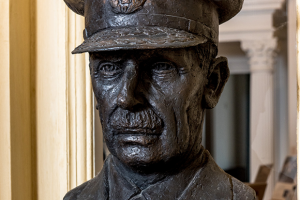Dimensions: 68cm high
Materials: Fibreglass and Resin
To listen to the audio description of this object either click the object audio MP3 file below which will play it in your default audio player, or press the play button which you will find after the object audio MP3 file and this will play it from within the web page. The play button can also be used to pause the audio. This button is followed by the elapsed and remaining time, and a further button to mute the audio.
Bust of Air Chief Marshal Sir Hugh Dowding Audio MP3 File
Air Chief Marshal Sir Hugh Dowding’s bust sits on a plain wooden plinth in the Entrance Hall at Bentley Priory Museum. It is made of fibreglass and resin with a bronze finish and is mounted on a white marble base. The bust is slightly larger than life size, over half a meter high, which immediately gives it a feeling of prominence.
The bust portrays Dowding as an older gentleman, with a pensive facial expression. He was 58 when he was Commander-in-Chief of Fighter Command at RAF Bentley Priory during the Battle of Britain in 1940. He has a moustache and is wearing his RAF cap with RAF insignia. He is wearing a shirt and tie and the lapels of his jacket are also visible. The overall surface has a slight texture and so it does not appear smooth. This also causes the surface to appear slightly dulled rather than shiny as you may often find with bronze statues.
Sir Hugh Dowding was a pilot during the First World War and progressed through the ranks of the RAF. He received a knighthood and in 1936 he was appointed the first Commander-in-Chief of Fighter Command at RAF Bentley Priory. A year later he was promoted to Air Chief Marshal. Dowding’s leadership and technological vision were essential to RAF victory during the Battle of Britain. He developed the world’s first integrated system of air defence; this innovative system of communications was known as The Dowding System. It used new developments in radar technology and the work of the Observer Corps to detect incoming enemy aircraft and ensure that RAF squadrons were scrambled in the right position and height to intercept them. Although Dowding’s nickname was Stuffy, he cared deeply about his fighter pilots and fought for improvements in pilot safety. He also understood and appreciated the role of women during the war.
The artist of the bust is unknown but it was produced to commemorate the 50th Anniversary of the Battle of Britain in 1990. It had been broken into numerous pieces but was expertly restored during the development of the Museum. Prince Charles, the Prince of Wales, is patron of the Museum’s governing Trust and unveiled Dowding’s bust in September 2013 when he officially opened the Museum.
 What’s On
What’s On Opening Hours & Admission
Opening Hours & Admission

